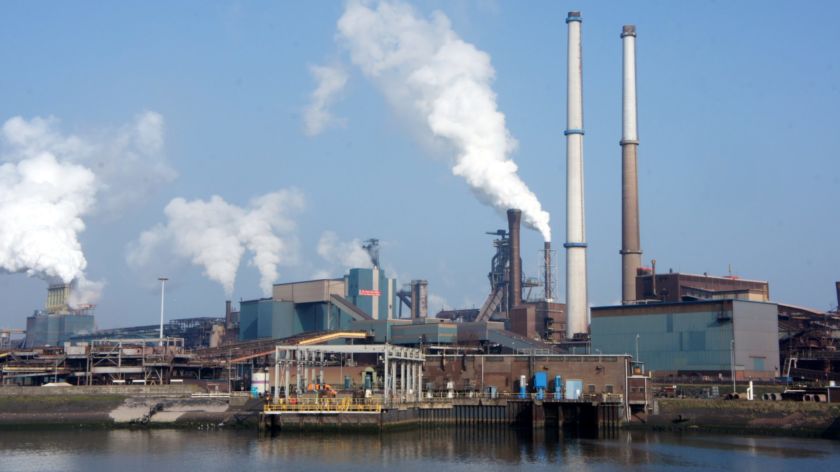-
 Tata Steel in IJmuiden. Photo: Wikimedia Commons
Tata Steel in IJmuiden. Photo: Wikimedia Commons
The emission of greenhouse gases needs to be reduced right now, as stated by the UN climate panel IPCC in a new report today. CO2 recycling would appear to be a useful tool in this endeavour. However, according to a new publication by PhD candidate Kaine de Kleijne, it is a lot less useful than first thought.
It sounds like the perfect solution for reducing CO2 emissions: simply take the greenhouse gas from the sky or siphon it off at energy plants, reuse the gas for something else and less of it will be emitted. One would think this is a welcome idea, especially now that the UN climate panel IPCC impressed the need for increasing the reduction of greenhouse gases in order to keep global warming to reasonable levels.
However, many of the techniques used for catching and reusing CO2 ─also known as CCU─ can’t live up to expectations. This is made clear in a publication by environmental scientists from Nijmegen, including the primary author, PhD candidate Kiane de Kleijne. ‘Obviously it sounds like a fantastic idea, but unfortunately in many cases it has turned out too good to be true.’
Tanker trucks
The results of the research were published in the scientific journal One Earth this month. In their paper, the researchers analyse earlier studies on the various CCU techniques that are either currently in use or in development. De Kleijne: ‘You can use CO2 to make plastic, convert it into construction materials like concrete, or implement it in the greenhouse industry.’ One example is garbage disposal company AVR in Duiven. After burning, AVR transports the remaining CO2 to horticulturists in the east of the Netherlands.
In their analysis, De Kleine wonders if reuse of CO2 is effective enough to commit ourselves fully to it, and if the techniques have been developed sufficiently to make a difference in accomplishing the Paris climate goals.
International agreements have set a goal for maximum increase in temperature of 1.5 degrees Celsius. That means that greenhouse gas emissions need to be reduced by 50% in 2030 when compared with 2020. Twenty years after that the number of emissions needs to be zero. To reach these goals, the government has stimulated the development of CCU projects using subsidy grants.
In its infancy
This new study from Nijmegen looked at the emission of the entire recycling process – starting at how the gas is siphoned off, up to the use of the final product. After analysis, it turned out that only a handful of CCU techniques led to fewer emissions in the short term.
‘Using the current techniques will keep us lagging behind the Paris goals’
An important cause of this is that many of the techniques have only been used in labs, according to De Kleijne: ‘A lot of methods are still in their infancy.’ This is a problem. De Kleine: ‘2030 is already coming up fast. The technologies that are now being developed in laboratories simply won’t be done in time for large-scale application; that means we will keep lagging behind the Paris goals.’
More emissions
And while recycling might sound environmentally friendly, De Kleine emphasizes that the recycling process itself often also costs energy. ‘For instance, when turning CO2 into a fuel such as methanol, in many cases you need to use hydrogen. And the production of hydrogen costs a lot of electricity. Reuse might sound like it leads to fewer emissions, but that isn’t always the case.’
To separate the wheat from the chaff, the researchers put forward three criteria that recycling CO2 should adhere to. First, the CO2 needs to be stored permanently, so that the greenhouse gas won’t enter the atmosphere at a later date. Second, it needs to be taken from either the sky or the burning of biomatter, rather than fossil fuels. And finally, there should be no CO2 emissions when converting a greenhouse gas to a new product. ‘We’ve found that technologies have to adhere to two out of three criteria in order to contribute the 2050 goals of the Paris agreement’, according to De Kleijne.
Oil fields
One example that was surprisingly effective in the short term is the use of CO2 as a propellant in oil fields. This is a common technique in the United States. ‘They inject CO2 into fields that are almost empty to get the last few bits of oil out of there’, according to De Kleijne. ‘But this technique is only beneficial to the environment if you put more CO2 into those reservoirs than the use of the oil creates. That is not true in most cases.’
‘One can use CO2 to turn waste from the steel industry into alternatives for concrete’
According to the PhD candidate, one of the CCU techniques that can help in the long term is turning CO2 into construction materials. ‘They use waste from the steel industry for this purpose. CO2 binds itself to minerals and forms carbonates, which can be used in construction as an alternative to concrete. The good thing is that this process requires very little energy, and the material is permanent; the CO2 will be contained for the most part.’
CO2 recycling is still seen as a circular alternative for permanent CO2 storage below grounds, such as underneath the North Sea. De Kleijne has her doubts. ‘I wonder if we should present recycling as the end goal when it does not prevent CO2 from going up in the air. In the end, the most important thing is preventing more CO2 from entering the atmosphere.’




